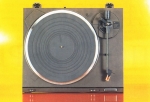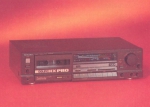Technics SL-1500 Turntable
At a first glance, this Technics SL-1500 does not look very different from the SL-1300 but in fact it is somewhat simpler, being a manual player, whereas the SL-1300 is automatic.
At the front right-hand corner is a combined on/off speed selector knob, sensibly placed well clear of the pickup headshell (other designers please note). The large aluminium diecast platter has a sloping outer edge carrying the four rows of dots to give stroboscopic indication of mains speed synchronism at 33-1/3 or 45 rpm with 50 or 60Hz mains illumination. The built-in neon lamp for this purpose has a mirror which reflects the light through a glass prism and clearly shows the state of the strobe from any angle. The DC brushless direct-drive motor rotates at the record speed, of course, and the platter itself acts as the rotor. The resultant streamlining makes this a very slim design indeed and the total effect of neatness and clean lines is aided by the silver and black finished aluminium motorboard and cabinetry.
Speed control is electronic, independent of the mains frequency, and fully stabilized, with separate 33-1/3 and 45 rpm knobs at the front left-hand corner to give ± 5 % fine speed adjustment. All the expected advantages of direct-drive should accrue, including very long life for all bearings and moving parts in view of the low rotational speed. Rumble and other system noise should be pretty well below audibility under all conditions, as should that other bugbear of more archaic turntable designs, wow and flutter. The power consumption of the motor is a mere 0.1w which means that heating effects must be negligible and component failure virtually eliminated.
The S-shaped pickup arm is as near as I can tell identical to that on the SL-1300 unit. It is a stylish design, though the gimbal suspension main pivot looks a little cumbersome. Playing weight is set by the usual counterbalance weight and concentric dial marked at 0.1 gram intervals from 0 to 3.9g. A separate knob with 0 to 3g marks applies the side-thrust (antiskating) bias compensation. The lift-lower lever has hydraulic slow-motion action and the sensibly shaped arm-rest has a locking clip to hold the arm safely when not in use.
The headshell has the 4-pin bayonet plug fitting which is now an almost universal standard and a slot screw fitting to permit accurate setting of the effective pivot-to-stylus distance (overhang). Accessories include a special overhang gauge, which can do double service as a stand for a spare headshell, and a stereo phono-to-DIN plug adaptor to simplify connection to an amplifier with 5-pin DIN inputs. The mains and low-capacitance signal leads attached to the turntable unit itself are of generous length. The clear plastic lid is strong and fitted with eminently sensible slide-in hinges which will support it at any desired angle. The unit stands on four anti-vibration feet to reduce the ill effects of knocks and acoustic feedback.
How it performed
Like its predecessors, the Technics SL- 1500 proved to be a joy to use. I tried several different cartridges, including some requiring low playing weight and low arm inertia, and satisfactory tracking could be obtained within the recommended playing weight range in all cases. The overhang gauge was extremely useful for quick and confident setting of the effective arm length. I believe that the instructions would be more helpful if they also indicated the proper distance from stylus to gauge to give the optimum arm height setting. The height of cartridge bodies varies a fair bit and some of the shallower models could usefully be packed out with washers to ensure that the arm is truly horizontal when playing a record.
I checked the calibration of the playing weight dial against a laboratory gauge and, except for a tendency to under-read by up to 0.1g, it was exact. The antiskating dial was accurate enough too for most purposes, though I prefer to set this function by ear, listening for the setting which appears to give cleanest tracking on both left and right channels. Incidentally, though the bar on which the arm rests has a rubberised top, the friction this produces is only slight and so I found that the anti-skating torque could cause the arm to swing outwards during the time of actually lowering. This is an annoying fault (common to many arms, not excluding the SME 3009) and I have often resorted to attaching a small piece of rough Elastoplast to give increased friction. Only then can I confidently line up the stylus over a given band on the record and cue it exactly. If the arm on this Technics model were to swing out while lowering on to a record, a nasty accident might occur if the stylus came down on the strobe dots on the platter periphery.
Tracking error was within the claimed limits of 3° at the outer edge and 1° at the end of the record. Mechanical noise is so low that I would defy anyone to tell blindfold that the motor was running. Rumble is quoted in the instructions according to three standards; the un-weighted DIN 455 39A figure is -50dB and my attempts to measure this, with test records having noise at about the same level (!), certainly confirm that rumble is just about too low to measure with any degree of confidence. Wow and flutter measured 0.04% which is again excellent.
In trems of styling, suitability for purpose and operational smoothness, the Technics SL-1500 can scarcely be faulted. The starting torque is such as to bring the record up to correct speed in about a single revolution and the arm lowering takes a satisfactory, and smooth, two seconds. For anyone seeking a manual record player with integrated arm and fine technical performance, I can recommend this model unreservedly.




